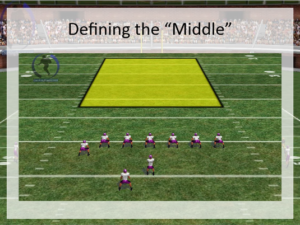By Sam Nichols
X&O Labs
The "Pre-Snap" read is far from an innovative concept. Every quarterback is taught to do it in some way as he prepares to run the next play.
The difference between "making a read" and "making a purposeful read" all goes back to teaching. Coaches that tell the QB to "look at the defense and take what they give you" will find that this only works if you have a coaches son at the helm. Furthermore, many coaches stop short of teaching the rest of the offense how to use the information that they gather in conjunction with what the QB communicates to maximize the potential of every single play.
For that reason, I have always found it best way to create consistency for all players is to have a standardized approach to identifying and communicating pre-snap information. This means we will use the same format every play for all positions. Here is a look at how I have taught this concept.
What is a pre-snap read?
- Definition: A survey of the defense to determine the play / scheme that they are going to run.
- Objective: Identify their play to speed up the decision that we must make once the ball is snapped.
- Result: Allows us to better attack our opponents weaknesses and avoid their strengths forcing them to change their plans and giving us control.
From there, we outline for our guys what that means to them on a play-by-play basis.
What are they reading?
Every snap, the players will identify pieces of information that will define the defense and allow us to "play fast". This information is, of course, different for the various positions. For instance, the Offensive line is very interested in understanding who is in the box, but they likely don't need to be concerned about the depth of the corner. To simplify this whole process for the players, we have broken down the diagnosis into four distinct areas. They are as follows:
 #1: The Number of players in the "Middle"
#1: The Number of players in the "Middle"
The middle of the field is defined as the area from hash to hash and over tackle to tackle This read is basically telling the Quarterback and receivers how many safeties are involved in the defense allowing them to fit their routes, stems, and blocking concepts to fit that alignment. It also helps us eliminate coverages and check into better vertical passing concepts. The quarterback communicates the box information as part of the snap count.
#2: The Number of players "Box"
The box is the area between the tight ends to the heels of the deepest linebacker. This tells us how many players are dedicated to the run / are in a position for a quick blitz at the snap of the ball. The line and backs need to be aware so that they can diagnose where their lanes and landmarks might be depending on the number of defenders and their arrangement in the box. The quarterback also uses this number to determine if the play can be run or if a check needs to be made to get us out of a bad play.
#3: The Edge
The tackles, tight ends, and wide receivers must understand how the defends plans to play the edge of our alignment. That means identifying and communicating the technique of the end man on the line of scrimmage and the force defender on that side. This information effects blocking assignments and route angles.









